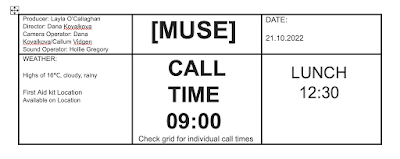TV News - Production Paperwork
Branding, GFX concepts and pitch
I developed the brand concept and identity in-line with our chosen demographic, creating a diverse array of options for logos. on-screen graphics and alternate logos. These options were presented to the group to provide feedback and for a democratic decision to be made. Each option was and illustrated using Procreate on the iPad and all content used was from previous work that I had created. This meant that Muse was built from the ground up, without relying on pre-existing stock footage or generic logo-making apps, establishing its aesthetic as entirely independent.
You can view the pitch here.
 |
| Some alternatives for 'MUSE' branding. |
Finding key contributors, creating a News script including Presenter introduction and News package V.O.
I found key Contributors for one of our news pieces online and got in touch with them to develop a rapport via email and phone. I also arranged the filming times and location of the 'homelessness' part of the package and disseminated the information to the group, as well as the crew who were participating in the shoot. At this location, I recorded sound and interviewed simultaneously- something that I'd not had to do prior to now.
I created a News script to accompany both pieces, as well as the V.O. I found this challenging as this was very different to my usual writing and required brevity. Writing the script also brought with it an element of research, the News had to be authentic and rely on objective data. You can find examples of some of the sources used in the pitch, as well as view the original script here, or the formatted post-production script here.
Finding and arranging a suitable location
In order for our channel aesthetic to feel consistent, the location had to be right. I created a mood board, to offer a visual component to guide our research:
I then set out to find local industrial spaces, before teaching staff suggested Chatham Dockyard. I reached out to one of the Y3's on the course who had a contact, Stephen, at the dockyard and after emailing Stephen, he was more than willing to accommodate our shoot and has since said that he'd be happy for us to shoot at the dockyard again. The other locations were determined by the whereabouts of the subjects; Fort Amherst for instance was where the 'Big sleep out' took place, and Brian's home was the second.
 |
| The 'Tarred Yarn store' at Chatham Dockyard. This was used as our studio space. |
Interviewing Contributors
I had prepared questions ahead of time and during our interviewing techniques workshop with Beth, worked on rehearsing these as if they were real scenarios. Doing this helped me to further refine the questions I had and brainstorm new ideas within the group. I began by considering the five principal questions that are needing to be answered; Who? When? What? Why? When? During interviews, I made sure to be open to following new lines of enquiry rather than sticking to a script and tried as best possible to be naturalistic and conversational to help the contributor feel comfortable. You can view the base list of questions here.
The casting process was a collaborative effort within the group, with the Producer creating an advert based on characteristics our group had determined we were looking for. We then reviewed showreels for those that applied and agreed on who we believed to be the best fit for the Presenter and V.O. respectively.
 |
| Our presenter Mike's headshot from his Mandy profile. |
Costume
The costume was an important part of the process that could have been easily missed. Every other aspect of the aesthetic had been considered and I thought it was important that the costume appeared consistent to the style we were going for. Originally, our presenter Mike had planned to wear a bright blue shirt and a smart, cream cotton blazer. One of the other members of the group had created a mood board including neutral colours and materials that would be appropriate to the shoot, but the presenter didn't have anything suitable. He said that he was happy to wear anything that we provided, so I put together three neutral-toned outfits that would complement the environment and work cohesively with our aesthetic.
 |
| The outfit worn by our presenter, Mike. |
 |
| An excerpt from the call sheet. |







Comments
Post a Comment